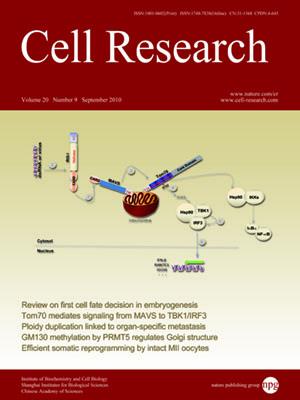
Volume 20, No 9, Sep 2010
ISSN: 1001-0602
EISSN: 1748-7838 2018
impact factor 17.848*
(Clarivate Analytics, 2019)
Volume 20 Issue 9, September 2010: 1060-1075
ORIGINAL ARTICLES
Cellular processing determinants for the activation of damage signals in response to topoisomerase I-linked DNA breakage
Ting-Hsiang Huang, Hsiang-Chin Chen, Shang-Min Chou, Yu-Chen Yang, Jia-Rong Fan and Tsai-Kun Li
Department and Graduate Institute of Microbiology, College of Medicine, National Taiwan University, No. 1, Section 1, Jen-Ai Road, Taipei 10018
Correspondence: Tsai-Kun Li,(tsaikunli@ntu.edu.tw)
Recent studies have suggested an involvement of processing pathways for the initiation of cellular responses induced by topoisomerase-targeting drugs. Here, we showed that cellular exposure to camptothecin (CPT) induced formation of topoisomerase I cleavable complex (TOP1cc), degradation of TOP1 and activation of DNA damage responses (DDR). Transcription and proteasome-dependent proteolysis, but not replication, were involved in CPT-induced TOP1 degradation, while none of above three processing activities affected TOP1cc formation. Replication- and transcription-initiated processing (RIP and TIP) of TOP1cc were identified as two independent pathways, which contribute distinctly to various CPT-activated DDR. Specifically, in cycling cells, RIP-processed TOP1cc triggered the CPT-induced RPA phosphorylation. At higher CPT dosages, the TIP pathway is required for other DDR activation, including ATM, p53 and Chk1/2 phosphorylation. The TIP pathway was further demonstrated to be S-phase independent by using three nonreplicating cell models. Furthermore, the effect of proteasome inhibitors mimicked that of transcription inhibition on the CPT-induced activation of DDR, suggesting the involvement of proteasome in the TIP pathway. Interestingly, the TIP pathway was important for TOP1cc-activated, but not ionization radiation-activated ATM, p53 and Chk2 phosphorylation. We have also found that pharmacological interferences of TIP and RIP pathways distinctively modulated the CPT-induced cell killing with treatments at low and high dosages, respectively. Together, our results support that both RIP and TIP pathways of TOP1cc are required for the activation of CPT-induced DDR and cytotoxicity.
Cell Research (2010) 20:1060-1075. doi: 10.1038/cr.2010.95; published online 6 July 2010
FULL TEXT | PDF
Browse 2077


